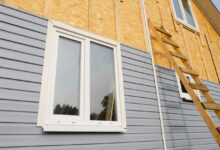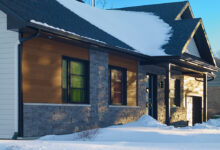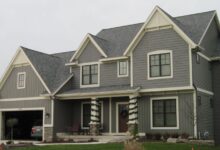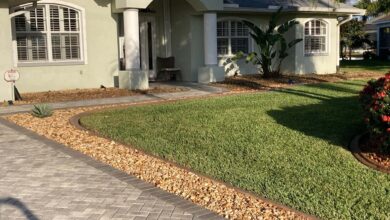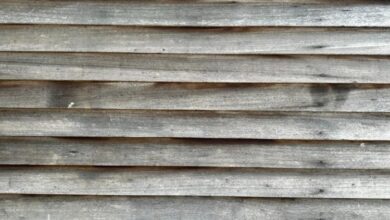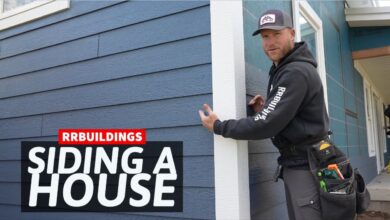Fiber Cement Siding vs. Vinyl: A Comprehensive Comparison
Fiber Cement Siding vs. Vinyl: This comparison delves into the crucial differences between these two popular exterior cladding options. We’ll explore their manufacturing processes, aesthetic appeal, durability, installation complexities, environmental impact, and long-term cost implications, helping you make an informed decision for your next home improvement project. Understanding the nuances of each material is key to choosing the siding that best suits your budget, architectural style, and long-term goals.
From initial cost to lifespan and maintenance needs, we’ll dissect every aspect, providing a balanced perspective to aid your decision. Whether you prioritize low maintenance, superior durability, or a specific aesthetic, this comparison will equip you with the knowledge to select the ideal siding for your home.
Initial Comparison
Choosing between fiber cement and vinyl siding involves considering several key factors. Both offer durable exterior cladding options, but their manufacturing processes, lifespans, costs, and maintenance requirements differ significantly. Understanding these differences is crucial for making an informed decision that aligns with your budget and long-term goals.
Manufacturing Processes
Fiber cement siding is a composite material made from a mixture of Portland cement, cellulose fibers (often wood pulp), and silica sand. The mixture is formed into panels, cured under pressure, and then often treated with a protective coating. This process results in a dense, durable product resistant to fire, moisture, and insect damage. In contrast, vinyl siding is manufactured from polyvinyl chloride (PVC) resin. The resin is extruded into panels, often with embossed textures to mimic wood grain or other materials. Vinyl siding is relatively simple and inexpensive to produce, making it a widely available and cost-effective option.
Lifespan and Warranty Expectations
Fiber cement siding generally boasts a significantly longer lifespan than vinyl siding. While fiber cement can last 50 years or more with proper maintenance, vinyl siding typically lasts 20-30 years. Warranty periods reflect these differences. Fiber cement siding manufacturers often offer warranties of 30 years or more, covering defects in materials and workmanship. Vinyl siding warranties are typically shorter, ranging from 10 to 25 years, and often have limitations concerning fading or cracking due to weather exposure. For example, James Hardie, a major fiber cement siding manufacturer, offers a 30-year limited warranty on its products, while many vinyl siding manufacturers offer 10-15 year warranties.
Cost Comparison
The initial cost of fiber cement siding is considerably higher than vinyl siding. This difference is apparent in both material and installation costs. Fiber cement’s durability and strength often require more skilled labor for installation, leading to higher labor charges. However, the longer lifespan and lower maintenance requirements of fiber cement can offset the higher initial investment over the long term. For instance, a 2,000 square foot home might see a material cost difference of $10,000-$15,000 or more between fiber cement and vinyl siding. Installation costs will also vary based on region and installer, but typically add another significant amount to the overall project cost. Long-term maintenance costs for vinyl siding may include more frequent repainting or replacement of damaged panels, potentially exceeding the cost savings from the lower initial investment over the lifetime of the house.
Appearance and Aesthetics
The visual appeal of your home’s exterior is significantly impacted by the siding choice. Both fiber cement and vinyl siding offer a range of options, but their aesthetic qualities differ considerably in terms of color, texture, and ability to mimic natural materials. Understanding these differences is crucial for achieving the desired look for your home.
Fiber cement and vinyl siding each present distinct aesthetic advantages and disadvantages. While vinyl offers a wide variety of colors at a lower cost, fiber cement provides a more durable and realistic imitation of natural materials. This section will delve into a detailed comparison of their aesthetic properties.
Color and Texture Variety
Fiber cement siding boasts a surprisingly diverse palette, although typically not as extensive as vinyl. Manufacturers offer a variety of colors achieved through paint application, often mimicking the subtle variations of natural wood grains or the smooth consistency of painted surfaces. Textures can range from smooth to deeply embossed, providing options that resemble wood clapboard, shingle, or even stucco. Vinyl siding, conversely, excels in sheer color variety, with hundreds of shades and patterns available, including those designed to mimic wood grain, stone, or brick. However, the textures in vinyl siding are often less realistic and may appear less substantial than fiber cement’s options.
Mimicking Natural Materials
Both fiber cement and vinyl siding attempt to replicate the look of natural materials, primarily wood. Fiber cement siding, due to its manufacturing process, can achieve a more convincing wood-grain texture. High-quality fiber cement siding often features deep, varied grooves and shading that effectively replicate the appearance of real wood, particularly when using a stained finish. Vinyl siding, while offering wood-grain patterns, often appears somewhat plastic and less authentic. The patterns may be repetitive and lack the subtle variations found in real wood. While advances in vinyl technology are improving this, fiber cement generally maintains a more realistic representation of wood.
Aesthetic Appeal Across Architectural Styles
| Siding Type | Victorian | Ranch | Modern |
|---|---|---|---|
| Fiber Cement | Excellent; can effectively mimic wood clapboard or shingles, offering a historically accurate look. Allows for intricate detailing and a wide range of colors. | Good; can achieve a clean, classic look with lap siding. Durable and low-maintenance, suitable for the style’s practicality. | Good to Excellent; depending on the chosen texture and color, it can provide a sleek, contemporary look. Can be used to create clean lines and geometric patterns. |
| Vinyl | Fair; While offering a range of colors, it may lack the authenticity and texture detail needed for a truly convincing Victorian aesthetic. | Good; Offers a wide variety of colors and styles suitable for a Ranch house’s simple design. Cost-effective and easy to install. | Fair to Good; Modern designs can be achieved with smooth vinyl siding in neutral tones. However, more textured options might appear less sophisticated. |
Durability and Maintenance
Choosing between fiber cement and vinyl siding involves careful consideration of long-term durability and the associated maintenance needs. Both materials offer distinct advantages and disadvantages in terms of their resistance to damage, weathering, and the overall upkeep required to maintain their appearance and structural integrity. Understanding these differences is crucial for making an informed decision that aligns with your budget and lifestyle.
Fiber cement and vinyl siding exhibit different strengths and weaknesses when exposed to the elements and potential damage. This section details their performance in key areas of durability and the maintenance required to keep them looking their best.
Impact Resistance
Fiber cement siding boasts superior impact resistance compared to vinyl. Its cement composition makes it significantly more resilient to dents and damage from impacts such as hail or accidental collisions. Vinyl, while durable, can dent or crack more easily under similar stress. For example, a strong hail storm might leave noticeable blemishes on vinyl siding, requiring repair or replacement, while fiber cement would likely withstand the impact with minimal to no visible damage. This difference in impact resistance translates to lower long-term repair costs for fiber cement in areas prone to severe weather.
Resistance to Fading and Moisture
Fiber cement’s inherent composition offers excellent resistance to fading from prolonged sun exposure. The color is typically integrated into the material, preventing the surface from peeling or fading as quickly as vinyl. Vinyl siding, while often treated with UV inhibitors, is still susceptible to fading over time, particularly in regions with intense sunlight. Regarding moisture, fiber cement’s non-porous nature makes it highly resistant to water damage, rot, and mold growth. Vinyl siding, while generally water-resistant, can be susceptible to moisture intrusion if not properly installed, leading to potential warping or damage.
Maintenance Requirements
Fiber cement siding generally requires minimal maintenance. Periodic cleaning with water and a soft brush is usually sufficient to remove dirt and debris. Repairs, while possible, are more complex and often require professional assistance due to the material’s density. Vinyl siding, on the other hand, is easier to clean and repair. Simple washing with soap and water can address most dirt accumulation. Minor repairs, such as replacing damaged panels, can often be undertaken by a homeowner with basic DIY skills.
Susceptibility to Warping, Cracking, and Insect Infestation
Fiber cement siding is exceptionally resistant to warping, cracking, and insect infestation due to its dense and non-porous nature. Insects find it difficult to penetrate, and its strength minimizes the risk of cracking or warping under normal conditions. Vinyl siding, while generally resistant to insect damage, can warp or crack if exposed to extreme temperatures or improper installation. For example, insufficient ventilation behind the siding can trap moisture, leading to warping and potential cracking, especially in areas with significant temperature fluctuations throughout the year. Additionally, while rare, some types of insects can still potentially damage vinyl siding, although this is less common than with wood siding.
Installation Process
Choosing between fiber cement and vinyl siding often hinges on factors beyond aesthetics and durability; the installation process itself plays a significant role. Both materials present unique challenges and require different skill sets and tools. Understanding these differences is crucial for budgeting time and resources, and for determining whether DIY installation is feasible.
Fiber cement and vinyl siding installation methods differ considerably, impacting project timelines and labor costs. Vinyl siding is generally considered easier to install for DIYers due to its lighter weight and simpler fastening mechanisms. Fiber cement, while offering superior durability, requires more expertise and specialized tools due to its weight and the need for precise cutting and fastening to avoid cracking.
Fiber Cement Siding Installation
Installing fiber cement siding demands precision and attention to detail. The material’s weight and susceptibility to cracking necessitate careful handling and the use of appropriate tools. Improper installation can lead to structural issues and compromise the siding’s longevity.
The necessary tools include a circular saw with a fine-tooth blade specifically designed for fiber cement, a measuring tape, a level, a nail gun (capable of handling appropriate fasteners for fiber cement), safety glasses, and a respirator (due to the potential for dust inhalation during cutting). Experience with carpentry and power tools is highly recommended.
A step-by-step guide for installing a small section might include:
- Measuring and cutting the fiber cement panels to the required dimensions, ensuring accurate cuts to minimize waste and maintain a consistent look.
- Preparing the wall surface, ensuring it is clean, dry, and free from any debris or loose materials that could compromise the bond between the siding and the wall.
- Installing starter strips along the bottom of the wall to provide a level and consistent base for the siding panels.
- Attaching the fiber cement panels to the wall using appropriate fasteners, ensuring proper spacing and alignment to prevent buckling or warping.
- Caulking seams and joints to prevent water penetration and maintain the siding’s weather resistance.
- Installing J-channels, corner trims, and other finishing pieces to complete the installation and provide a neat, professional finish.
Vinyl Siding Installation
Vinyl siding installation is generally considered more straightforward than fiber cement. Its lightweight nature and simpler fastening system make it a popular choice for DIY projects. However, proper installation techniques are still crucial to ensure a long-lasting and aesthetically pleasing result.
Tools required include a measuring tape, a level, a utility knife or scissors, a hammer or nail gun (depending on the fastening system), and possibly a jigsaw for intricate cuts. While less demanding than fiber cement installation, basic carpentry skills are still beneficial.
A step-by-step guide for a small section could follow these steps:
- Measuring and cutting the vinyl siding panels to the required dimensions using a utility knife or scissors. Vinyl siding is relatively easy to cut, requiring less specialized tools.
- Installing starter strips or J-channels along the bottom of the wall to create a consistent base for the panels. This provides a clean, straight edge to begin the installation.
- Attaching the vinyl siding panels to the wall using nails or staples, ensuring proper overlap and alignment to prevent gaps or misalignment. Overlapping panels are crucial for water shedding.
- Installing corner trims, J-channels, and other finishing pieces to complete the installation and provide a professional finish. These components ensure a neat appearance and protect edges.
- Caulking any gaps or seams, although vinyl siding is designed to be relatively watertight, caulking enhances its weather resistance.
Environmental Impact
Choosing between fiber cement and vinyl siding involves considering their respective environmental footprints. Both materials have impacts throughout their lifecycles, from manufacturing and transportation to eventual disposal or recycling. A comprehensive comparison requires examining each stage to determine the overall environmental burden.
Manufacturing fiber cement siding typically requires more energy than producing vinyl siding. This is primarily due to the high temperatures needed for the cement curing process and the energy-intensive extraction and processing of raw materials like cement, sand, and cellulose fibers. Vinyl siding, on the other hand, is derived from petroleum, a non-renewable resource, and its production involves significant energy consumption and greenhouse gas emissions. However, the manufacturing process for vinyl is generally less energy-intensive than that of fiber cement.
Manufacturing and Disposal
The manufacturing processes for both fiber cement and vinyl siding contribute to greenhouse gas emissions. Fiber cement production releases carbon dioxide during cement production and energy consumption, while vinyl siding production relies on petroleum-based resources, leading to significant carbon emissions. Disposal also presents challenges. Fiber cement, while potentially recyclable in some regions, often ends up in landfills. Vinyl siding, similarly, is not readily recyclable and frequently contributes to landfill waste. The volume of waste generated and the potential for leachate contamination are environmental concerns for both materials.
Recyclability and Sustainability
Recyclability varies significantly between fiber cement and vinyl siding. Fiber cement components, such as cellulose fibers, can sometimes be recycled or reused, though this depends on regional recycling infrastructure. However, the cement component often makes recycling challenging. Vinyl siding has extremely limited recyclability, primarily due to the difficulty in separating and purifying the PVC polymer. Therefore, from a sustainability perspective, fiber cement generally performs better due to the potential for some component recycling and its longer lifespan. The longevity of fiber cement siding, reducing the frequency of replacement, indirectly contributes to reduced environmental impact compared to more frequently replaced vinyl siding.
Carbon Footprint
Assessing the total carbon footprint of each siding type is complex and depends on several factors, including manufacturing processes, transportation distances, and end-of-life management. Studies comparing the lifecycle carbon footprints of fiber cement and vinyl siding often show varying results, depending on the specific assumptions and data used. However, generally, both materials have a significant carbon footprint, with fiber cement potentially having a slightly higher embodied carbon due to the energy-intensive cement production. The transportation distance and the method of disposal greatly influence the overall carbon footprint for both. For instance, a locally manufactured and recycled fiber cement siding would have a lower carbon footprint than vinyl siding shipped from across the country and ultimately disposed of in a landfill.
Fire Resistance and Safety
Choosing between fiber cement and vinyl siding involves considering their respective fire safety profiles. Both materials react differently to fire, presenting distinct safety implications for homeowners and impacting building codes compliance. Understanding these differences is crucial for informed decision-making during home construction or renovation.
Fiber cement siding, a composite material containing cement, cellulose fibers, and other additives, possesses significantly better fire resistance than vinyl siding. Its inherent composition contributes to its superior performance in high-heat environments.
Fire Resistance Ratings
Fiber cement siding generally achieves a Class A fire rating, the highest classification for exterior wall coverings. This indicates its exceptional ability to resist and withstand fire spread. Conversely, vinyl siding typically receives a Class C fire rating, signifying a lower level of fire resistance and a greater susceptibility to ignition and rapid burning. The difference in ratings directly reflects the materials’ inherent properties and how they behave under fire conditions. A Class A rating denotes a material that will not contribute significantly to the spread of a fire, whereas a Class C rating indicates a greater likelihood of fire spread.
Safety Implications of Fire Hazards
The contrasting fire ratings translate to substantial differences in safety implications. A home clad in fiber cement siding offers greater protection against fire spread, minimizing the risk of rapid fire progression during a fire event. This characteristic enhances the safety of occupants and provides more time for evacuation. In contrast, vinyl siding, due to its flammability, can significantly accelerate fire spread, posing a greater risk to life and property. The rapid melting and burning of vinyl siding can release toxic fumes, adding another layer of hazard. Imagine a scenario: a small fire starting near a home’s exterior. With fiber cement, the fire would likely be contained, providing crucial time for intervention. With vinyl siding, the fire could rapidly engulf the entire structure.
Building Codes and Regulations
Building codes and regulations often incorporate fire-resistance requirements for exterior wall coverings. These codes vary by location, but generally favor the use of fire-resistant materials like fiber cement siding, especially in high-risk areas or for structures with specific fire safety concerns. Many jurisdictions may mandate or incentivize the use of Class A materials, like fiber cement, to minimize fire risks within the community. Conversely, restrictions or limitations might be placed on the use of less fire-resistant materials, such as vinyl siding, especially in areas with stringent fire safety codes. Compliance with these codes is paramount to ensure the safety and structural integrity of buildings.
Insulation and Energy Efficiency
Fiber cement and vinyl siding, while both offering exterior protection for homes, differ significantly in their contribution to a building’s overall insulation and energy efficiency. Understanding these differences is crucial for homeowners considering the long-term costs and environmental impact of their siding choices. The thermal properties of each material directly influence how effectively a house retains heat in winter and stays cool in summer.
Fiber cement siding, being a composite material, offers slightly better insulation properties than vinyl siding. However, the difference is often marginal and depends heavily on the thickness of the siding and the presence of additional insulation within the wall cavity. The impact on energy efficiency is therefore not solely determined by the siding itself, but rather the entire building envelope.
Fiber Cement Siding’s Thermal Performance
Fiber cement’s slightly higher density compared to vinyl contributes to a modest improvement in thermal resistance. This means it can slightly impede the transfer of heat, resulting in a marginally lower energy consumption for heating and cooling. However, this effect is usually overshadowed by other factors such as window insulation, wall construction, and attic insulation. The thermal performance of fiber cement siding is often expressed in terms of R-value, a measure of thermal resistance. While a precise R-value for fiber cement siding is difficult to state without knowing the specific product, it generally falls within a range that provides minimal insulation compared to dedicated insulation materials within the wall cavity. A home with well-insulated walls will experience a greater reduction in energy costs regardless of whether it has fiber cement or vinyl siding.
Vinyl Siding’s Thermal Properties
Vinyl siding, being a plastic material, is a relatively poor insulator. Its low density and composition mean heat transfers more readily through it than through fiber cement. Consequently, a house clad in vinyl siding may require more energy for heating and cooling, especially in climates with extreme temperature variations. The R-value of vinyl siding is typically even lower than that of fiber cement, contributing to less effective heat retention. This doesn’t automatically mean significantly higher energy bills; other factors like window efficiency and overall building design play a much larger role. However, in regions with harsh winters or scorching summers, the difference in thermal performance between the two materials might become more noticeable in the long run.
Impact on Heating and Cooling Costs
The difference in energy consumption between homes using fiber cement and vinyl siding is typically modest. While fiber cement offers slightly better insulation, the overall impact on heating and cooling costs is usually small compared to other factors influencing energy efficiency. For example, improvements in window insulation, better sealing of air leaks, and upgrading attic insulation would have a far greater effect on reducing energy bills. To illustrate, consider two identical homes, one with fiber cement siding and one with vinyl siding, both with poorly insulated walls. The difference in their energy consumption would be minimal. However, if one of those homes undergoes significant wall insulation upgrades, the energy savings would be far more substantial than the marginal difference attributed to the siding material alone. In essence, while siding choice plays a small part, it is a relatively minor factor in the larger context of energy efficiency.
Moisture Resistance and Water Damage
Choosing between fiber cement and vinyl siding often hinges on their respective abilities to withstand moisture. Both materials aim to protect your home from water damage, but they achieve this through different mechanisms and with varying degrees of success. Understanding these differences is crucial for making an informed decision.
Fiber cement and vinyl siding exhibit vastly different water absorption rates. Vinyl, being a plastic polymer, is essentially impermeable to water. Fiber cement, a composite of cement, sand, and cellulose fibers, is more porous, though modern manufacturing techniques significantly reduce its water absorption. However, even with these improvements, fiber cement will absorb some moisture, particularly under prolonged exposure to heavy rain or humidity.
Water Absorption and Prevention
Fiber cement’s inherent porosity, while minimized, means it can absorb some moisture. This absorbed moisture can lead to issues like swelling, cracking, and potential damage if not properly managed. Effective sealing and proper installation are critical to minimize water penetration. Manufacturers often recommend applying a high-quality sealant to all seams and joints during installation. Regular inspection for cracks or damage, and prompt repair, are also vital for preventing moisture-related problems. The use of flashing around windows and doors is also crucial in diverting water away from the siding. In the event of significant water damage, replacing affected sections may be necessary.
Vinyl siding, by contrast, largely resists water absorption. Its non-porous nature prevents water from penetrating the material itself. However, water can still infiltrate the wall system behind the vinyl through gaps or improper installation. Therefore, proper installation, including the use of sufficient flashing and careful sealing around windows and doors, remains crucial even with vinyl. While vinyl is less susceptible to water damage than fiber cement, standing water or prolonged exposure to moisture can still lead to problems like mold growth behind the siding if there are any gaps in the wall system allowing moisture penetration.
Addressing Moisture-Related Issues
Addressing moisture issues in fiber cement siding typically involves identifying the source of the leak (e.g., damaged flashing, cracked siding), repairing the damage, and allowing the affected area to dry completely before resealing. In cases of severe water damage, replacement of the affected section might be required. For vinyl siding, addressing moisture problems often involves inspecting for gaps or cracks around windows, doors, or other penetrations in the siding. Caulking or replacing damaged sections are common solutions. Addressing moisture problems behind vinyl siding may require more extensive repairs, potentially involving opening the wall to treat any mold or water damage.
Soundproofing Capabilities
Both fiber cement and vinyl siding offer some degree of sound dampening, but their effectiveness varies significantly. Understanding these differences is crucial for homeowners and builders aiming to minimize noise intrusion in various settings. The materials’ density, thickness, and installation method all play a role in their soundproofing performance.
Fiber cement siding, due to its denser and more rigid nature compared to vinyl, generally provides superior sound insulation. Its mass effectively absorbs and blocks sound waves more efficiently. This makes it a more suitable choice for areas with significant noise pollution, such as homes near busy roads or airports.
Sound Dampening Mechanisms
The sound dampening properties of both materials stem from their ability to absorb and reflect sound waves. Fiber cement’s higher density leads to greater sound absorption, while vinyl, being less dense, relies more on reflection. However, even with reflection, vinyl’s performance is limited, especially at higher frequencies. The effectiveness of both materials is also influenced by the underlying wall construction; a well-insulated wall will enhance the soundproofing capabilities of either siding type.
Noise Reduction in Different Environments
In residential settings, fiber cement siding provides better protection against external noise, such as traffic or neighborly conversations. This difference becomes more pronounced in areas with higher noise levels. For instance, a home situated near a busy highway would experience a noticeable reduction in noise penetration with fiber cement compared to vinyl. In commercial settings, such as office buildings or retail spaces, the superior sound insulation of fiber cement can contribute to a quieter and more productive work environment, particularly in areas adjacent to noisy machinery or high-traffic zones.
Factors Affecting Soundproofing Performance
Several factors beyond the siding material itself influence the overall soundproofing performance of a building. These include the type and thickness of the underlying wall insulation, the quality of window seals, and the construction of the building’s framework. A poorly insulated wall, for example, will significantly reduce the effectiveness of even the best siding in blocking sound transmission. Similarly, gaps or poorly sealed windows can create pathways for sound to penetrate, negating the benefits of superior siding. Therefore, a holistic approach to soundproofing involves considering all elements of the building’s construction.
Long-Term Costs and Value
Choosing between fiber cement and vinyl siding involves a long-term financial commitment. While initial costs might differ, the true picture emerges when considering maintenance, repairs, potential replacements, and the impact on your home’s overall value. Understanding these factors is crucial for making an informed decision that aligns with your budget and long-term goals.
Fiber Cement Siding: Long-Term Cost Analysis
Fiber cement siding boasts a significantly longer lifespan than vinyl, typically lasting 50 years or more with proper maintenance. This longevity translates to fewer replacements over the long term, offsetting higher initial costs. However, the material’s durability doesn’t eliminate maintenance entirely. Regular cleaning to remove dirt and debris is necessary, and occasional repainting might be required to maintain its aesthetic appeal and protect against weathering. Repairs, while less frequent, can be more costly than vinyl repairs due to the specialized skills often needed. Considering a hypothetical 20-year period, the costs might include initial installation (estimated at $8,000-$15,000 depending on house size and complexity), periodic cleaning (approximately $200-$500 every 2-3 years), and potential repainting (approximately $2,000-$5,000 every 10-15 years). Unforeseen repairs could add further expense.
Vinyl Siding: Long-Term Cost Analysis
Vinyl siding’s lower initial cost is a major draw, but its shorter lifespan (typically 20-30 years) means more frequent replacements. While maintenance is generally less demanding than fiber cement—requiring mostly occasional cleaning—the need for complete replacement sooner will significantly impact long-term costs. Using the same 20-year timeframe, the initial installation cost might be $5,000-$10,000. Cleaning costs would be similar to fiber cement, but the major expense would be a potential full replacement around the 20-year mark, costing another $5,000-$10,000, potentially negating any initial cost savings. While repairs are often cheaper and easier, the frequency could potentially balance out the cost differential over time.
Impact on Home Value and Resale Price
Both siding types can positively impact a home’s value, but the extent varies. Fiber cement’s superior durability and longevity often appeal to buyers, potentially commanding a higher resale price. Appraisers often recognize the long-term value proposition of fiber cement, leading to a higher appraisal. Conversely, while vinyl can enhance curb appeal, its shorter lifespan might be a factor considered by buyers, potentially leading to a lower resale price compared to homes with fiber cement. The overall condition of the siding will always be a factor, regardless of material. A well-maintained vinyl siding will still enhance the value compared to a poorly maintained fiber cement siding.
Return on Investment (ROI) over 20 Years
Calculating precise ROI requires numerous variables (labor costs, material prices, local market conditions), but we can illustrate potential scenarios. A home with fiber cement siding might have higher initial costs but lower replacement and repair expenses over 20 years, leading to a potentially better ROI compared to vinyl. For example, a home with $12,000 fiber cement installation, $1,000 in maintenance, and $3,000 repainting over 20 years versus a home with $8,000 vinyl installation, $1,000 in maintenance, and an $8,000 replacement at year 20. While the vinyl home might seem cheaper initially, the replacement cost significantly impacts the overall 20-year cost. The exact ROI depends on specific costs and regional variations. The key is to consider the total cost of ownership over the expected lifespan of each siding type.
Choosing the Right Siding
Selecting the right siding for your home involves careful consideration of several key factors. The ideal choice depends on a complex interplay of budget constraints, regional climate conditions, and the architectural style of your house. Understanding these factors will help you make an informed decision that maximizes both aesthetic appeal and long-term value.
Budgetary Considerations
Budget significantly influences siding material selection. Vinyl siding generally presents a more affordable upfront cost compared to fiber cement. However, the lower initial investment in vinyl might be offset by higher maintenance costs over the siding’s lifespan. Fiber cement, while initially more expensive, offers superior durability and longevity, potentially leading to lower long-term expenses. For instance, a homeowner with a limited budget might opt for vinyl, accepting the need for more frequent repainting or repairs, while a homeowner prioritizing long-term cost-effectiveness might choose fiber cement despite its higher initial price.
Climate and Environmental Factors
Climate plays a crucial role in siding material selection. Fiber cement excels in regions with extreme weather conditions, exhibiting superior resistance to strong winds, hail, and heavy rain. Its durability makes it a worthwhile investment in areas prone to severe storms or harsh winters. Conversely, vinyl siding may be a suitable choice in milder climates, where it can provide adequate protection without the higher cost of fiber cement. For example, a homeowner in a hurricane-prone coastal area would benefit greatly from the impact resistance of fiber cement, whereas a homeowner in a consistently mild, dry climate might find vinyl to be perfectly sufficient.
Home Style and Architectural Design
The architectural style of your home significantly impacts the visual appeal of different siding materials. Fiber cement’s versatility allows for a wide range of colors, textures, and profiles, making it suitable for various architectural styles, from traditional to contemporary. Vinyl siding also offers a variety of styles and colors, but its ability to convincingly mimic the look of natural materials like wood or stone may be limited. A home with a craftsman style might benefit from fiber cement’s ability to replicate the look of wood clapboard, while a modern home might be better suited to vinyl’s sleek and clean lines.
Decision-Making Flowchart
The following flowchart provides a structured approach to selecting between fiber cement and vinyl siding:

